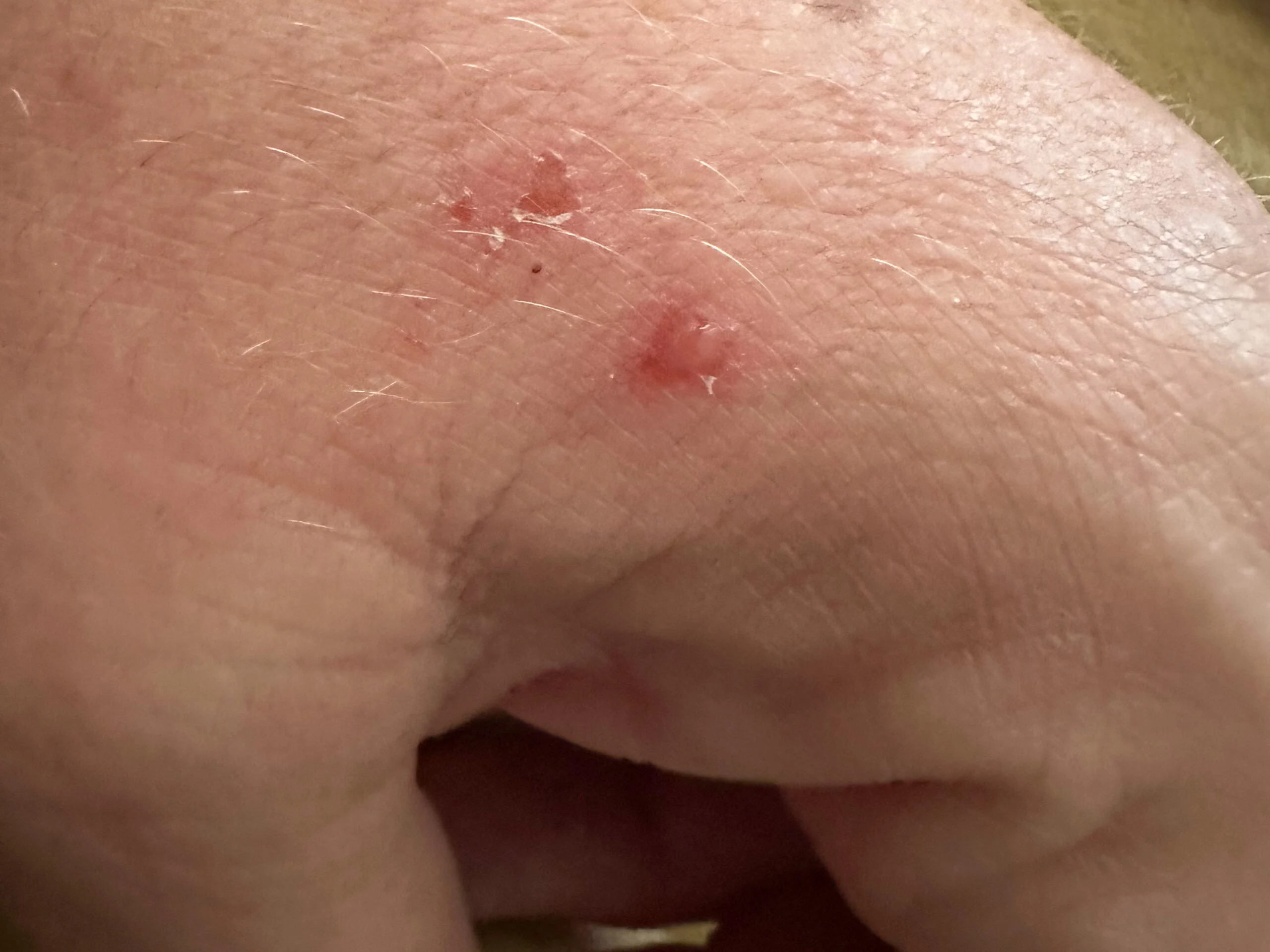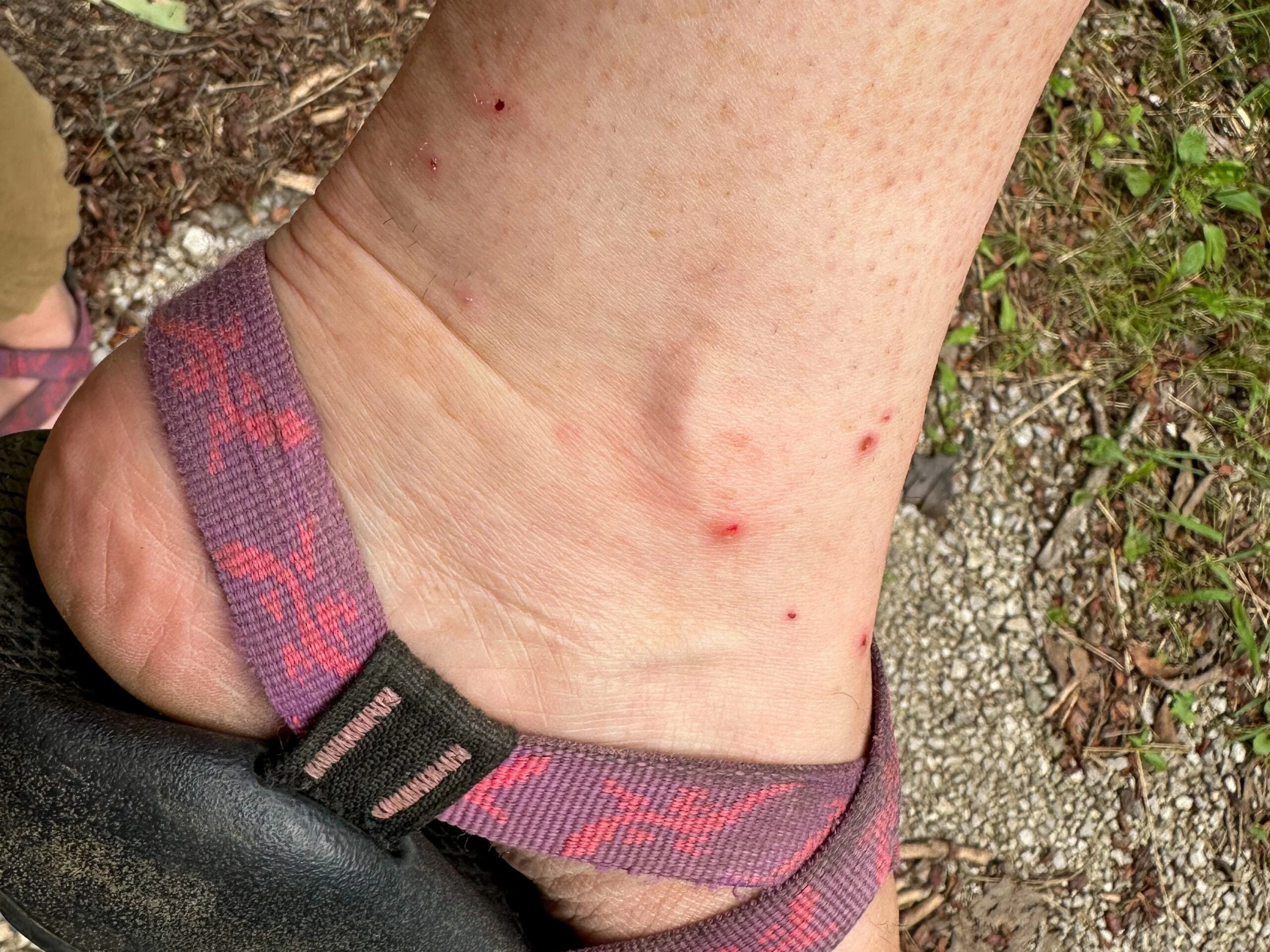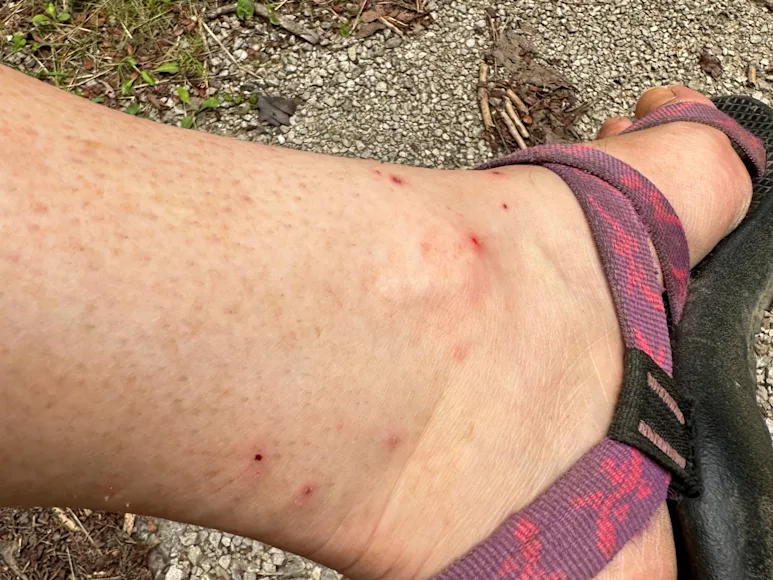As far as dangers in the outdoors go, getting a few chigger bites isn’t exactly on par with stumbling upon a hornet’s nest or, say, a bear. Yet for those who have had the misfortune of meeting these tiny mites, the experience is nothing short of memorable. The sensation of relentless itching and irritation that chigger bites bring can put a dampener on your outdoor activities. This guide is crafted to shed light on chiggers: pinpoint the areas they inhabit, illustrate how to identify their bites, and, most importantly, guide you through the most effective treatment methods of how to treat chigger bites.

Chigger bites look like small red welts. As much as you can, avoid scratching them to reduce the chance for infection. Jennifer Caudill
Table of Contents
How to Treat Chigger Bites
What Do Chigger Bites Look Like?
What Are Chiggers?
Where Do Chiggers Live?
FAQs
How to Treat Chigger Bites
Knowing how to treat chigger bites properly—and doing so promptly—can prevent infection and alleviate discomfort. Here’s a step-by-step guide to treating chigger bites effectively:
Wipe Down: If you’ve been in an area that you suspect may have had chiggers, wipe down commons bite spots—feet, ankles, behind your knees, armpits—with a dry hand towel.
Clean Up: When you notice chigger bites, thoroughly clean the area with soap and water. This simple step can prevent potential infections.
Avoid Scratching: Though the itching can be intense, avoid scratching to prevent breaking the skin and introducing bacteria, which can lead to infections.
Topical Treatments: Products like calamine lotion or corticosteroid creams can significantly reduce the itching and inflammation of chigger bites. One commercial product we have found to be very successful is Chigarid
.
Oral Medications: If the itching is unbearable, considering oral antihistamines might be a good idea. They can help in reducing the allergic reactions caused by the bites. During a recent trip out with my dog, he got numerous chiggers on his front legs after walking through the grass that I was able to avoid. Our vet relieved some of the itching with an oral antihistamine for him. Keep in mind that use of these for you or your pets brings on likely drowsiness.
Cold Compress: A cold compress can be applied to the affected areas for immediate relief. This helps reduce inflammation and soothe the itch. Seek medical advice if the symptoms worsen or if signs of infection appear.
What Do Chigger Bites Look Like?
Identifying bites is the first step towards knowing how to treat chigger bites. These bites have some distinguishing features which set them apart from other insect bites. Here’s how you can recognize them:
Appearance: Chigger bites appear as red welts, which may resemble blisters or pimples. The red bumps are often clustered and exhibit an intense reddish hue. Remember that without a magnifying glass, you cannot see the actual chigger. If you are experiencing redness and itching, you can no longer remove the insects from your skin. It is too late. This is another reason to avoid likely areas that hold them.
Location: Chiggers prefer warm, constricted areas of the body. It’s common to find bites around the ankles, behind the knees, waist, and even armpits. Even though I do all I can to avoid them, I still get them occasionally. My most likely area is right around the top of my sock line. Once I started wearing taller socks and spraying repellant on my shoes, pant bottoms, and socks (along with the avoidance strategies mentioned above), I rarely get them now, even though I am in prime habit during the summer months.
Reactions: One of the hallmarks of chigger bites is the unbearable itch that seems to escalate as time passes. This is due to the enzymes released by chiggers, which cause a reaction in the skin cells. Understanding these bites’ typical locations and appearances can aid in swift identification and treatment, preventing secondary complications like bacterial infections caused by scratching.

Ankles are a common spot to find chigger bites. If you spend time in an infested area, wipe off your ankles with a dry cloth once you’re back. Jennifer Caudill
Chigger Bites vs Other Insect Bites
How do chigger bites compare to bites from other annoying culprits? Here’s a quick breakdown:
Chigger Bites vs Mosquito Bites
Mosquito Bites usually raised, soft, and accompanied by a mild to moderate itch.
Chigger Bites vs Tick Bites
Tick bites are characterized by a clear central bite point and can sometimes be accompanied by a rash. The tick will often be embedded in the skin.
Chigger Bites vs Spider Bites
Spider bites often showcase two-fang marks and can be accompanied by swelling and redness. Since I spend much time outside and sleeping on the ground, I have had numerous non-venomous spider bites. You may question this fan- mark indicator. Don’t. It is almost always a tell-tale sign of a spider bite
What Are Chiggers?
are mites found in grassy areas. They have many localized names, including harvest mites, harvest bugs, harvest lice, mower’s mites, red bugs, or the most common, chiggers. They are known for their intensely itchy bites, characterized by red welts commonly seen in warm, constrained areas of the body. Preventing infection and alleviating discomfort can be achieved by cleaning the affected area, abstaining from scratching, and utilizing topical application lotion and antihistamines.
Small Bugs, Big Bite
Chiggers are often mistakenly identified as insects. They are more accurately, and scientifically, known as Trombiculidae—minuscule arachnid family members (like spiders and ticks) nearly invisible to the naked eye. Despite their tiny size, their impact on humans is anything but insignificant. Even though these little guys cannot be seen, the aftermath of discomfort and significant irritation is problematic to humans and pets.
Life Cycle of a Chigger
Understanding the lifecycle of chiggers can be crucial in avoiding their bites. They go through several stages of development, from eggs to larvae, which is the stage where they bite, and then further into nymph and adult stages, where they no longer feed on hosts. The awareness about their feeding patterns and lifecycle stages can equip individuals with the knowledge needed to avoid areas heavily infested with chiggers and take preventive measures during outdoor activities.
Chiggers start their life with eggs laid in grassy or wooded areas. Find a grassy area inside a wooded area, during hot and humid weather, and you have hit the jackpot of chigger country. Once hatched, the larvae seek out hosts to feed on, including various animals or humans.
What Do Chiggers Feed On?
Contrary to popular belief, chiggers do not feed on blood. They feed on the skin. They do this by releasing enzymes that dissolve skin cells, which they then consume. It is when these skin cells dissolve that the insufferable itching starts. While not harmful in the long run, this process leads to intensely itchy and red welts on the skin. Do whatever it takes to not scratch. Yes, I have been there and done that, too, but it is best to avoid scratching.
Where Do Chiggers Live?
Chiggers predominantly inhabit grassy fields, gardens, wilderness areas, and parks, thriving in areas with a moist and dense vegetation cover. These environments provide them with ample opportunities to find hosts and sustain their lifecycle. These highly humidity-dependent creatures are commonly found in damp areas with high moisture levels. These microscopic pests cluster in groups, increasing the probability of multiple bites if you walk through a chigger-infested area. Identifying these potential chigger habitats can be instrumental in avoiding unpleasant encounters with them. That is the #1 way to avoid getting these bites.
When Do Chiggers Bite?
I have two of very cool facts about chiggers for you: The first is their preference for feeding in the early morning and late afternoon hours. During these times, the temperature and humidity levels are optimal for them. Additionally, they seem to have a penchant for shaded areas over sunny spots, as extreme temperatures can harm their survival. Second is the massively big-word process called parthenogenesis. This process is where asexual reproduction can occur in rare circumstances. This means the sheer number of chiggers may explode in the sweltering and humid conditions. he little buggers rapidly increase on their own to help further the species.
To protect yourself from chiggers, it’s advisable to avoid sitting or lying down on the grass in known chigger-infested areas, especially during peak feeding times. Taking precautions like wearing long-sleeved clothing and applying insect repellent can help steer clear of chigger bites.
FAQs
How long do chigger bites last?
Chigger bites can be persistent, varying from one to two weeks. The acute phase of itching generally subsides within a week, but the red marks and minor itching can linger for another week.
Do chigger bites spread by scratching?
Scratching does not cause chigger bites to spread, as chiggers do not replicate through scratching. However, scratching can exacerbate the skin’s condition, potentially leading to secondary bacterial infections, which can spread if not treated appropriately.
How do you stop chigger bites from spreading?
Maintain hygiene by keeping the area clean, apply antibiotic ointment to prevent bacterial infections, and avoid scratching the affected areas. Implementing these steps can curb progression and prevent secondary complications.
Does rubbing alcohol kill chigger bites?
Rubbing alcohol doesn’t “kill” chigger bites (remember that if you are itching, the have already done their work on you), but it can be a disinfectant to clean the area and provide temporary relief from the itch. If you choose to use rubbing alcohol, follow it up with a moisturizer to prevent skin drying.
Continue Reading…
Now that you know how to treat chigger bites, consider learning the same for another nasty bug that’s commonly encountered in the outdoors: Ticks. Check out the following guides ticks.






